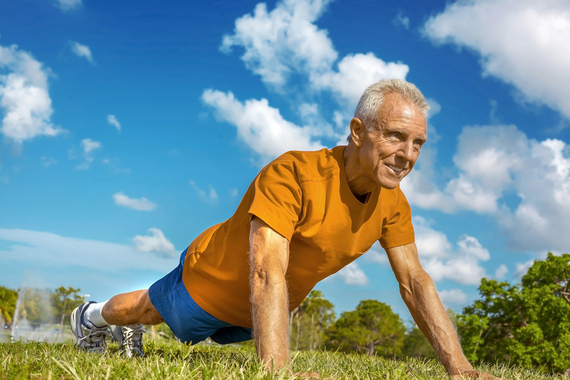Healthy old people die from falling. They trip, break their hip and then have a mortality rate of up to 58 percent in the first year. [1] These days, there are lots of devices and apps to monitor elderly and frail people and help them if they fall, but by then it is too late.
As we age, we develop three major physical weaknesses: weak muscles, weak bones and poor balance. [2] Since we all want to live well until the day we die, how do we solve these three problems?
Here is how.
Weak muscles are mostly from disuse and low natural testosterone. [3] Often the advice people are given for their aches and pains is go home and rest, further weakening all the structures. In China, many old people are in the public parks performing Chinese dances and Tai Chi. Our old people are home watching TV. We can change this. Exercise programs designed to build muscle should be part of everyone's day. An entire field of elderly sports and fitness training would do wonders for our aging population. Progressive, competitive, creative fitness programs that focus on muscle building work for the elderly but are rarely encouraged. We need CrossFit to become AgeFit.
Bone responds to stress. More stress stimulates the body to make stronger bones. Lack of stress on the bones leads to mineral loss and weakening. [4] Increasing stress by resistance exercises, such as weight lifting, is proven to be the most effective bone building activity at all ages. Elderly weight lifting gyms and programs should be the norm. Wheelchair bound elderly people can learn from wheelchair bound young people to exercise their upper body and trunk muscles. As our patients say, "getting old is not for sissies." It takes courage, determination, coaching and education to build bone, and it is worth it.
Balance. If you live near the water and can swim, the number one new best exercise for balance is stand-up paddling. It can be done at any age. By widening the board to the width of a door anyone can stand on one. The constant balancing and gentle paddling strengthen the trunk and core muscles while working on the small muscles of the feet and the neuro-sensory or proprioceptive feedback system improves balance more than any other activity. Indoor balancing activities by standing on one leg on a pillow or small balance trampoline can work too but aren't as much fun. Balance training diminishes falling episodes. And falls kill.
So don't live like today is the last day of your life, live like you will live forever. If you want to grow old happily, train your body for the sport of aging and play on.
References
1. The 1-Year Mortality of Patients Treated in a Hip Fracture Program for Elders
Scott Schnell, MD,1 Susan M. Friedman, MD, MPH,1 Daniel A. Mendelson, MS, MD,1 Karilee W. Bingham, MS, RN, FNP,1 and Stephen L. Kates, MD1
2. Demontiero, O., Vidal, C., & Duque, G. (2011). Aging and bone loss: new insights for the clinician. Therapeutic advances in musculoskeletal disease, 1759720X11430858.
2. Evans, W. J., & Lexell, J. (1995). Human aging, muscle mass, and fiber type composition. The Journals of Gerontology Series A: Biological Sciences and Medical Sciences, 50(Special Issue), 11-16.
2. Konrad, H. R., Girardi, M., & Helfert, R. (1999). Balance and aging. The Laryngoscope, 109(9), 1454-1460.
3. Allan, C. A., Strauss, B. J. G., Burger, H. G., Forbes, E. A., & McLachlan, R. I. (2008). Testosterone therapy prevents gain in visceral adipose tissue and loss of skeletal muscle in nonobese aging men. The Journal of Clinical Endocrinology & Metabolism, 93(1), 139-146.
4. Ishijima, M., Rittling, S. R., Yamashita, T., Tsuji, K., Kurosawa, H., Nifuji, A., ... & Noda, M. (2001). Enhancement of osteoclastic bone resorption and suppression of osteoblastic bone formation in response to reduced mechanical stress do not occur in the absence of osteopontin. The Journal of experimental medicine, 193(3), 399-404.
4. Terai, K., Takano‐Yamamoto, T., Ohba, Y., Hiura, K., Sugimoto, M., Sato, M., ... & Nomura, S. (1999). Role of osteopontin in bone remodeling caused by mechanical stress. Journal of Bone and Mineral Research, 14(6), 839-849.
4. Hughes-Fulford, M. (2004). Signal transduction and mechanical stress. Science Signaling, 2004(249), re12.
